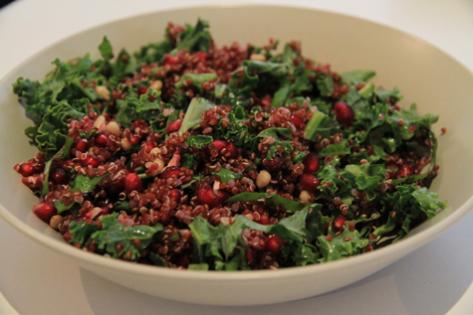We all know that eating fruit and veg is good for us. However, to ensure that your fruit and veg are providing you with the best flavour and nutrition, for the best value, it’s best to buy when they are seasonal and plentiful.
Each season I enjoy stumbling across fresh produce that I have never heard of, or used in my culinary life. It may seem crazy considering I talk about food for a living, but it just shows how lucky we are to have this diverse and vast availability of fresh produce on our door steps.
The two new kids on the Boogaard block have been Kale and Pomegranate. Although they have both been available over the summer months, these beauties are more seasonal during the Autumn-Winter months.
Kale
There are two main types of kale that you will find at your growers markets and supermarkets, including the curly leaved (my personal fave for salads) and the plain-leaved kale.
Kale is extremely popular at the moment especially amongst our ‘super food’ eaters. It is a green leafy vegetable (related to broccoli, Brussels sprouts and cauliflower) that boasts a wide variety of nutrients, rightly earning is current status.
Although I could not find any Australian data on the nutritional breakdown of kale, the US analysis can pretty much translate to what we find on our plate. Kale is high in:
- Antioxidants - Vitamin A, C and K and other phytonutrients
- Minerals including copper, magnesium, manganese, iron and phosphorus and
- Fibre with a fibre content much higher than most other green leafy vegetables.
To give you an idea of the high vitamin K content of kale, one to two tablespoons of kale gives you a similar amount of vitamin K as one whole cup of raw spinach, cabbage or bok choy.
Because kale is so high in vitamin K (which is a powerful antioxidant and also responsible for blood clotting and bone health) a word of warning needs to be made to those readers who are on anticoagulants such as warfarin. When a person takes warfarin they do not need to avoid vitamin K but ideally keep their intake consistent on a day-to-day basis in order to take the right dose. It’s best to chat with your doctor before you run out the door and load up on kale.
There are often big claims that kale contains calcium. Although it does contain some calcium, kale also contains oxalates, which interfere with the absorption of calcium. So not only should you not rely on kale for your calcium intake, but you should avoid having kale with calcium rich foods such as yoghurt and milk. For more information on calcium and bone health see my previous article on this.
Pomegranate
The pomegranate is such a delightful little fruit with more diversity than people may realise. Although I have had pomegranate infused foods and drinks in the past (I’m thinking of a pomegranate martini right now), I have never used it myself … until now!
My sister-in-law made the most beautiful pomegranate and fennel salad at Christmas time and we both now agree that once you start, you just can’t stop using this little delight!
Although it takes a little bit of labour to separate the edible seeds from the skin and white membrane, you definitely get the benefits from the flavour and the nutrients they provide. Pomegranates are rich in polyphenols (powerful antioxidants) and also contain:
- Fibre
- Carbohydrate
- Potassium
- Folate
- Vitamin C, and
- Beta-carotene.
Whether these two edible gifts from nature are new to you or ‘old flames’, I have created this recipe to help you enjoy the flavour and the nutritional benefits of kale and pomegranate at the same time.
Kale and Pomegranate Salad
Ingredients
1 cup of cooked red quinoa - I use red quinoa for its nutty texture and aesthetic appeal, you could also use other grains such as brown rice, faro or burghul (cracked wheat)
Seeds of one pomegranate
1 cup of chopped curly-leaved kale
¼ cup of chopped basil
2 tablespoons of pinenuts
1 teaspoon of olive oil
Juice from ½ a lemon (or to taste)
Method
1. Simply combine the ingredients for a lovely side dish or light meal.
2. Enjoy!



















__small.png)










